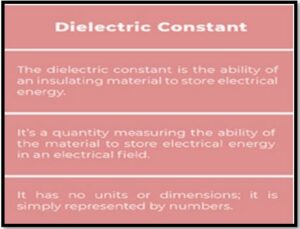Table of Contents

Introduction
A substance’s ways to retain electrical energy in an electric field are assessed by the dielectric constant. It is a characteristic of an electrically insulating material that is dielectric, and it is also defined as relative permittivity or specific capacity.
A brief outline
When the dielectric constant rises, the electric flux density rises as well, and the situation is such that almost all factors should stay the same. This allows items to retain their electric charge for extended periods of time and/or to hold enormous amounts of charge, such as a series of metal plates of a specific size.
Important concepts
The dielectric constant is a dimensional quantity. Air has a dielectric constant of 1.00059, paraffin has a dielectric constant of 2.25, water has a dielectric constant of 78.2, and barium titanate has a dielectric constant of 2,000 at ambient temperature.
Dielectric Constant Formula
Dielectric constant can be mathematically expressed as:
K = ε/ε0
κ = Dielectric constant
? = Permittivity of the substance
ε₀ = Permittivity of the free space
Dielectric Constant Units
Existence the ratio of two like entities is a unitless, dimensionless quantity.
Derivation
Dielectric constant (K) = Permittivity of the substance (ε) × [permittivity of free space (ε0)]-1
∴ Permittivity of substance = permittivity of free space = [Charge2] × [Force]–1 × [Distance]–2 – (1)
Charge = [I1 T1] – (2)
Distance = [M0 L1 T0] – (3)
Force = [M1 L1 T-2] – (4)
Replace eq (2), (3) and (4) in eq (1)
Permittivity (ε) or (ε0) = [Charge]2 × [Force]–1 × [Distance]–2
Since, Dielectric constant (K) = ε × [ε0]-1
Thus, the dielectric constant is dimensionally signified as [M0 L0 I0 T0] = Dimensionless Quantity.
Significance of dimensions of dielectric constant in IIT JEE exam
It is critical to take a holistic approach to every facet of a subject’s chapter. It will not only adequately prepare you for the exam, but will also clarify your understanding of each topic. It will help you pass the JEE exam’s conceptual problems. The number of questions from the chapter unit and dimensions would be one or two, with a weightage of roughly four marks.
FAQs
Q. Do materials with a high dielectric constant easily break?
Ans: When materials with high dielectric constants are exposed to severe electric fields, they are known to break down more easily than materials with low dielectric constants.
Q. What does the term “dielectric constant” mean?
Ans: The dielectric constant is the ratio of the permittivity of a substance to that of free space.
Q. What does Dielectric Constant stand for?
Ans: The dielectric constant, also known as the relative permittivity of a dielectric substance, is written with the Greek letter kappa “.









